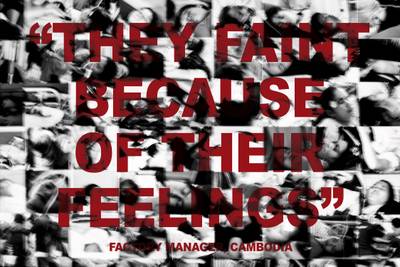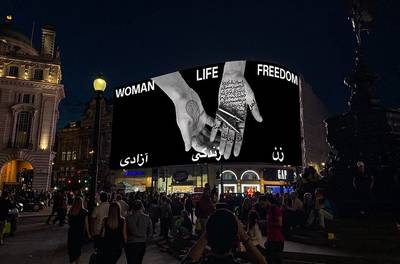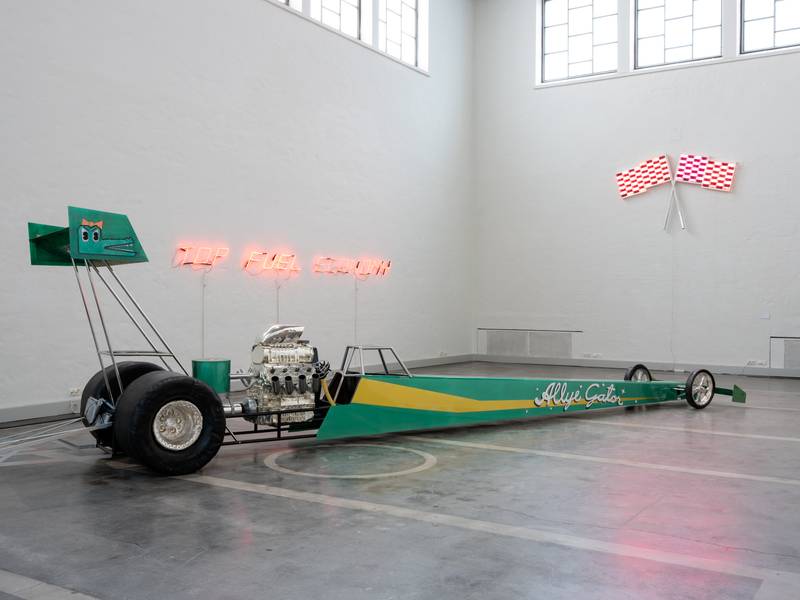

Photo: Patrik Rastenberger
Gabriella Presnal (b. 2001) is a Finnish-American fine arts student studying for a BA in Media and Arts at Tampere University of Applied Sciences. In their works, they are interested in queerness, philosophy, and the environment. They work in various mediums like installation, moving images, applied fine arts, and painting. They are currently working on their thesis inspired by queer nomads using video projection and sculpture.
From June 11 to August 28, 2022, Anssi Kasitonni displayed his works at Taidehalli. I was briefly familiar with his works through social media and particularly liked one of his previous works, The Simpsons (2021), which was not shown in this exhibition but depicted the classic couch intro from the same-name cartoon using silver-plated fiberglass and candy paints. I hadn’t read much into his work before seeing his solo exhibition. After my visit, I had more questions than answers, as is usual after visiting any number of art exhibitions. Unfortunately, the works exhibited at Taidehalli lacked individual artwork statements. The exhibition text broadly describes how his works “dive into the breathtaking world of fast cars, drag races, and motorsports” and provide a “window into the past, a nostalgic era of mass culture”.1
The first work I saw when entering the exhibition space was Thru a Lens (2022), a series of eight photographs, one of them depicting a sleek surface covered in various stickers. The first sticker that caught my eye had an eagle, wings fully extended, claws reaching out, overlaid on the confederate flag alongside a second eagle overlaid on an image of the US American flag. Cars driving around in the US with Confederate flags, “MAGA”, likely a Blue Lives Matter flag, and various assortment of stickable racist and fascist memorabilia immediately flashed in my mind.
I was also reminded of the works by Andres Serrano I saw earlier this year at Stockholm’s Fotografiska Museum. In his works, Serrano confronts white people’s racist history. There is a direct conversation with the objects and imagery he photographs and displays.2 Speed Records also originates from this reclamation. It is about power and taboo.
Similarly, I think about the works by Gran Fury from ACT-UP. Gran Fury’s most famous project is the Silence = Death (1987) poster. I hope many who are already familiar with ACT-UP (AIDS Coalition to Unleash Power) campaign also know that the pink triangle was reclaimed starting in the early 70s when gay concentration camp survivors were beginning to publish memoirs describing their experiences within the Nazi camps, the most well-known being Heinz Heger’s 1972 memoir The Men With The Pink Triangle.3 4 The symbol was used for activism against discriminatory housing policies in the Southern US and slowly gained traction through pop culture (e.g. The Rocky Horror Picture Show). It was most famously used in ACT-UP and by Gran Fury.5 6 I talk about Andres Serrano’s and Gran Fury’s works because these works have distinctively been about confronting and subverting the powers that be. These works demand you not to look away. This is not the case when I reflect on how I have seen the confederate flag being used within Finland.
When I reflected on the works from Speed Records, I questioned if there was supposed to be an element of parody. Was the use of the candy-colored paint intentional to comment on the glorification of US mass consumerism, specifically within the subculture of motorsports? Many works were created out of resin; was this to comment on the permanence of US-American mass culture? Or even the permanence of US-American cultural hegemony within the vast amounts of consumed nostalgia? Like consumable products, cultural media omnisciently persists through microplastics, carbon emissions, or successful propaganda. Was Thru the Lens existing simply to acknowledge that the motorsports culture is not without its faults? – to see reality from the photograph versus the nostalgic utopia built from the rest of his works? Or if it was merely documentation, why wasn’t there more interaction with this aspect of motorsports in the exhibition?
I was reminded of nostalgia critic Svetlana Boyd’s concept of restorative versus reflective nostalgia (exactly what they sound like). Reflective nostalgia is reflecting on the past but not wishing to recreate or return to that time. In comparison, restorative nostalgia is about wanting to restore time, society, one’s self, etc., to a previous state. Restorative nostalgia is primarily seen as more conservative, i.e. to return to traditional values. For example, restorative nostalgia is also one of the main reasons, if not the entire reason, why parents many times have rejected new forms of media, for example, comic books, video games, genres of music (e.g. hip-hop, punk rock), books, etc., but this is more or less futile as they want to return to an idealized past while ignoring all the issues of that particular time, or more worryingly, wish to restore the socio-political conditions of the past, likely in addition to the cultural aesthetics. While reflective nostalgia is more imaginary, reflecting on the alternative timelines that could have created a different present is often rooted in the discontent of the present and/or the imagined future. With reflective nostalgia, the past might act out in the present. Hence, reflective nostalgia can have a progressive impact, i.e. awareness of our history can change the present and future.7 8
With the excuses of it’s an aesthetic and “we’re Finnish, so it doesn’t mean anything here”, one might question does the Confederate flag (or other symbols) then lose its power and significance/relevance as it is in Finland, where it did not originate/have the same contextual power dynamics. As I understand, it doesn’t lose its power as that would assume Finland to be an isolated, neutral, and entirely nonviolent country when it comes to racial and ethnic equality. To have a neutral or even purely documentative stance without confrontation on white supremacist symbols is to assume white Finns are outsiders to white supremacy rather than beneficiaries.
Then, where are Thru the Lens and the rest of the Speed Records exhibition situated in relation to reflective or restorative nostalgia? If it is mere documentation, then the artist has provided no commentary, opinions, or insights about the violence of this symbol. In the US, the confederate symbol is a sure sign of saying you’re racist, and it is often a sign ‘reclaimed’ by those with confederate ancestors and a symbol of family heritage. Here, in Finland, because of the successful propaganda that it is just “family heritage”, it has been aestheticized in subcultures like its use in motorsports and Rockabilly; two prominent reasons why the Confederate flag and similar symbols/icons are in the United Daughters of the Confederacy (UDC) and the Sons of Confederate Veterans (SCV), which were not only active in erecting over 700 Confederate statues and monuments across the US south since they were founded in 1894, they were also active in creating the narrative in education institutions about the Confederacy. When I see the Confederate flag being used in Finland, I wonder if people associate it with a white supremacist symbol or not. What does the Confederate flag represent to those within these subcultures? While doing some light research on the UDC, I found they also actively promote the Lost Cause narrative.9 Ergo, the idea that the Confederacy had a noble role in the US Civil War and was a cause for “individual states’ rights, independence, and bravery” and “individualism, courage, and rebellion”.10 It is the latter three that I imagine European subcultures, like Rockabilly, motorsports, diinarit, and raggare, have latched onto. It has been more about rebellion against leftist and communist ideals in contrast to the more anti-capitalist punk subcultures.11
Regardless of the intentions of their use with the Confederate flag, its use in these nostalgia-based subcultures is the aestheticization of white supremacy. Not with the intentions of reclamation or subversion through satire and parody like ACT-UP or Serrano, but rather as a restorative gesture towards Confederate propaganda and an embrace of American whiteness. With the excuses of it’s an aesthetic and “we’re Finnish, so it doesn’t mean anything here”, one might question does the Confederate flag (or other symbols) then lose its power and significance/relevance as it is in Finland, where it did not originate/have the same contextual power dynamics. As I understand, it doesn’t lose its power as that would assume Finland to be an isolated, neutral, and entirely nonviolent country when it comes to racial and ethnic equality. To have a neutral or even purely documentative stance without confrontation on white supremacist symbols is to assume white Finns are outsiders to white supremacy rather than beneficiaries.
It is interesting to see how specifically it has been US hegemony that has been so successful, which perhaps reveals more of the inspirations behind these subcultures mentioned above, i.e., many of the associations in terms of the demographic within Rockabilly, motorsports, diinarit, and raggare are blue collar, and an apparent “low brow feel”.12 Finnish repulsion of the Soviet Union and Russia as a result of the Finnish Civil War then turned to favor US consumer culture starting in the mid-20th century. This slowly resulted in the Americanization of Finland, which isn’t even a small phenomenon in these specific subcultures either. This can be seen to varying degrees in businesses like Garageland, American Diner-themed restaurants, and even Kitty’s Milkshake Bar, as well as a variety of Rockabilly concerts (e.g. Rockabilly Rocks Festival), and nostalgia car shows I have noticed in Southern Finland.
When I think about these topics, I am reminded of the work Consumed Nostalgia: Memory of Fast Capitalism (2017) by Gary Cross.13 He describes several forms of nostalgia from its origins in 1800s Switzerland, its latest form, he has coined as consumed nostalgia. Some of the characteristics of consumed nostalgia that differ from past forms of nostalgia are, for example, consumed nostalgia may not necessarily be shared between family or your local community, but rather scattered individuals that connect with any number of subcultures. Consumed nostalgia is also quite specific from other forms of nostalgia as it’s about how we cope and what we use as signifiers under late-stage capitalism and mass consumerism. Consumed nostalgia originates from consumer products from our childhood and general youth versus nostalgia for religious icons, art, ceremonial clothing, etc. It has become a popular form of nostalgia as consumer culture is, as we all know, generally fun to take part in, temporarily gratifying, and even liberating. But as a result, consumed nostalgia can also invoke individualism within us. Isolating us from our local communities may also awaken our depressive hedonism alongside it. The solution given by Cross is to explore nostalgia from a more universal, communal aspect – to rather explore the nostalgia of our family members, such as grandparents, parents, siblings, and/or found family. In this form, consumed nostalgia goes against object fetishism and individualism and turns more towards realizing nostalgia from a reflective, universalist perspective.
What can then be said of these nostalgic subcultures, such as motorsports and rockabilly using the Confederate flag in Finland? These come from the origin of exploring/reinventing previous generations’ consumed nostalgia. Still, it becomes an odd twist of attempting to ‘reclaim’ and reinvent consumed nostalgia that does not originate from something within one’s heritage. It then almost becomes an attempt to claim US American whiteness over or in addition to Finnish whiteness (or perhaps to embolden their whiteness in general), a form of cultural appreciation for American white supremacist culture and heritage. I mention these things as a larger conversation around how US Americans consumed nostalgia has been presented in Finland.
Speed Records is a part of a more significant trend and history of restorative, consumed nostalgia in Finland of American cultural hegemony. For Finns within these subcultures, it is a history of appreciation tracing back to a post-war era where American goods (primarily cultural) were imported to Finland.14 As Cross notes in his book, nostalgia is often linked to two stages within our childhoods, the emerging autonomy found in primary-school-age childhood and then the consumer freedom within one’s emotionally charged adolescence. I mention this as the period of American consumed nostalgia, all resulting from the consumer freedom found in the 50-60s or within what we could call Finland’s adolescence. Hence, this conversation about the Americanized consumed nostalgia in Finland is often nostalgia from this adolescent period. Regardless of personal associations or intentions with the Confederate flag symbol, they, either way, reinforce the Lost Cause narrative.
Cross also mentioned that when we reflect on our consumed nostalgia, it should come from a universalist perspective to avoid radical individualistic consumption. When we usually talk about the aestheticization of politics, we mention the works of Mark Fisher and Benjamin Walters. They have described how universalist politics can be, and are, undermined through their aestheticization. One recent example I am reminded of is “Hello Kitty ACAB”, or similarly slapping any cartoon character with the acronym ACAB or BLM, which was prominent during the 2020 mass protests against police brutality surrounding the death of George Floyd. This seemingly simple act via social media channels trivialized the systemic abuse of power from police departments, and any government agency for that matter, in the US and elsewhere, as well as the movement that started shortly following the deaths of Black Americans at the hands of the police, such as Trayvon Martin, Pamela Turner, Micheal Brown, and Eric Garner. Benjamin explains that fascism aestheticizes politics, ergo that “fascism permits the proletariat to express their suffering through art—film, photography, painting—and having professed their pain, the system tricks the masses into temporary gratification, which allows the fascist system to continue.” In this way, we see that the Hello Kitty ACAB trivializes the issues it’s attempting to “raise awareness” by reducing it to an aesthetic (“permits the proletariat to express their suffering through art”) over an actual political movement. Similarly, Mark Fisher uses the example of the Pixar animated film Wall-E in chapter two of his book Capitalist Realism to talk about how films like this can perform our anti-capitalism and environmentalism for us (as gestural anti-capitalism).15 I imagine similarly, the aestheticization of the Confederate flag, whether in the US or here in Finland, does not confront, reclaim, or mock the taboo but normalizes its use for restorative nostalgia and trivializes it by reinforcing propaganda.
What can then be said of these nostalgic subcultures, such as motorsports and rockabilly using the Confederate flag in Finland? These come from the origin of exploring/reinventing previous generations’ consumed nostalgia. Still, it becomes an odd twist of attempting to ‘reclaim’ and reinvent consumed nostalgia that does not originate from something within one’s heritage. It then almost becomes an attempt to claim US American whiteness over or in addition to Finnish whiteness (or perhaps to embolden their whiteness in general), a form of cultural appreciation for American white supremacist culture and heritage.


Photo: Jukka Salminen
One of the largest works in the Speed Records exhibition, Top/Fuel/Economy (2022), was dedicated to Anita Mäkelä, a racer from Vilppula in Central Finland. A main point in the exhibition was that consumed nostalgia is not always isolating. Many times it can bring people together. I could see (and hope) Speed Records is attempting to come from a more reflective, universalist perspective, i.e. reflecting on the nostalgia he and the people around him have consumed nostalgia towards. It could be the case that Kasitonni, in an attempt to undermine male chauvinism, many of these subcultures have usually been claimed by, then turned to reflect on the profession and consumed nostalgia of the prominent Finnish racer Mäkelä.16 I find the information surrounding the exhibition and the artworks lacking, considering its associations with the Confederate flag pointed out within the very first work of the exhibition as, without further context, the intentions of the artist and Taidehalli become unclear. This still poses the question, does Speed Records antagonize the Americanization of Finland, critique it, or embrace it? Somehow it feels like none of the above. Perhaps it was simply a form of play with the past. And in this play, it was not deemed of especially high relevance to explore the context of this subculture in relation to the Lost Cause narrative and its socio-political origins in the US despite the colorful Americanized consumed nostalgia present throughout the entire exhibition. It seems to tiptoe or adds a dash of awareness and doesn’t directly talk about it for the rest of the exhibition.
In a larger conversation, this exhibition also asks what the relevance of consumed nostalgia in art is. Can there be, if any, involvement of it in creating a counter-culture to cultural hegemony such as Americanization? It can become quite a strict perspective (from Benjamin Walters, for example) to consider that all nostalgia is either commodifying or romanticizing childhood regardless of its restorative or reflective intention rather than it being under a certain economic system; nostalgia, like innovation, and art is alienated and intended to distract the public. As Frederic Jameson critiques, postmodernism is the cultural logic of late-stage capitalism as they are comprised of pastiche and revivalism, ergo, the conversation of reflective versus restorative all comes down to what is actually being said in this exhibition. Is it pastiche (restorative and embrace), or is it parody (reflective and critique)? I find it useful to compare it to another recent exhibition titled Cheeseburger Nostrum Cotidianum, this one showing the works of Riiko Sakkinen at Gallerie Forsblom (23.9. - 23.10.2022).17
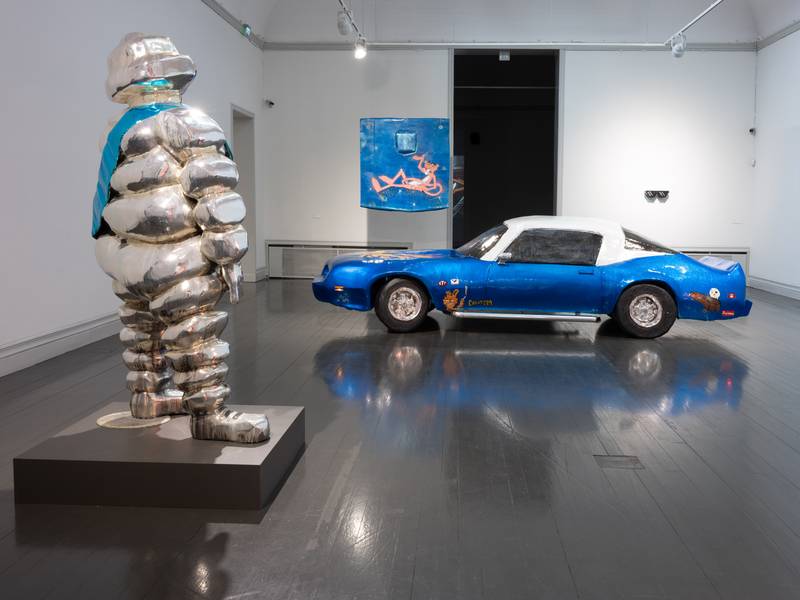

Installation view from Anssi Kasitonni’s exhibition Speed Records at Taidehalli Helsinki. Photo: Patrik Rastenberger
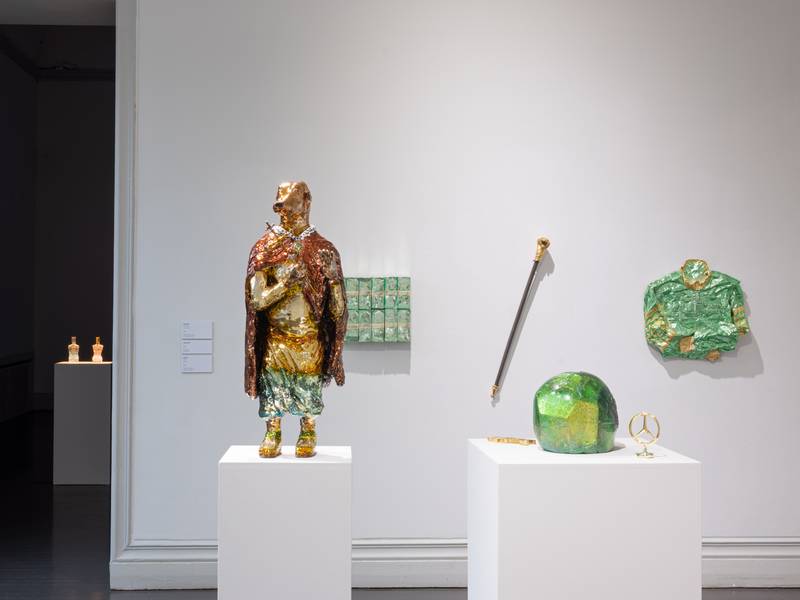

Installation view from Anssi Kasitonni’s exhibition Speed Records at Taidehalli Helsinki. Photo: Patrik Rastenberger
In a larger conversation, this exhibition also asks what the relevance of consumed nostalgia in art is. Can there be, if any, involvement of it in creating a counter-culture to cultural hegemony such as Americanization? It can become quite a strict perspective (from Benjamin Walters, for example) to consider that all nostalgia is either commodifying or romanticizing childhood regardless of its restorative or reflective intention rather than it being under a certain economic system; nostalgia, like innovation, and art is alienated and intended to distract the public.
I mention this exhibition because it directly ties into the relevance of consumed nostalgia in art today, especially in Finland. Most of the works, if not all, rely on parody and satire to critique consumed nostalgia. From McDonalds, KFC, Heinz, Looney Toons, and many more, Sakkinen uses these figureheads to make statements like “We have nothing to lose but our fast food chains” and “You can have it and eat it too if you are rich” which follow his art movement he has coined as Turborealism. Turborealsim, according to Sakkinen, is an anti-capitalist art movement “against your regime and its ass-lickers” and against globalized capitalism. Sakkinen subverts the consumer products and the characters they paint and transfer what (the product) one might use as a signifier into art, ergo, going back to previous forms of nostalgia where one’s signifiers for their identity were most likely not consumer products, but rather art, heritage, etc. Similar to how many artists create works using ready-mades to subvert their consumer, and sometimes, their capitalist function? This is interesting to think about as it is almost restorative for past nostalgia (i.e. restorative nostalgia for the act of being nostalgic for things like fashion and heirlooms versus consumer products) whilst being reflective in its critique of consumer products via parody (i.e. reflective in the sense that it is imagining another ‘timeline’ or function to consumed nostalgia). Versus Kasitonni uses the modern consumed nostalgia from a reflective perspective (whilst its lack of confrontation makes it feel more from a restorative perspective).
Critiquing Cheeseburger Nostrum Cotidianum feels alongside the lines of the argument “you’re anti-capitalist, yet you take part in capitalist structures”, and yet, I still question to what extent his works/exhibitions truly uphold his movement of selling the “car bomb” equivalent in art and having these bombs in every museum and every bank. Isn’t having these “car bombs” just another form of gestural anti-capitalism for the people who can afford these works (works ranging between €400 and €21K) and for Gallerie Forsblom, who exhibit them? And if so, how can we compare this to Kasitonni’s Speed Records? In the future of contemporary art, should we as creators (is there an ethical responsibility to) demand confrontation and parody, like Sakkinen, or should there be more play, moreover, exploration of consumed nostalgia, like Kasitonni? In the hypothetical situation, had Kasitonni more directly confronted the faults of the motorsports subculture, such as racist propaganda, would this have a similar critique as there is for Sakkinen of being a performative gesture? I am still interested in the future works of Kasitonni and Sakkinen as I wonder how their works will evolve further. How will Sakkinen attempt to create proletariat counter-hegemony in galleries, museums, etc.? How will Kasitonni evoke nostalgia in his future works, and how will it reflect the contemporary Finn? Will they contribute to (Finnish, the proletariat, and/or nostalgic) cultural growth in regard to art and our relationship to social memory? The age of consumed nostalgia is not going away, and there is a vast discussion on how it can be involved in art and culture, as discussed by Cross, Boyd, Walters, Jameson, Fisher, and many more. Speed Records and Cheeseburger Nostrum Cotidianum are just two recent examples of how consumed nostalgia is being represented in contemporary art, but neither imagine the future of nostalgia (what comes after consumed nostalgia? Is it possible to go beyond it?) which is perhaps one of the roots as to why their exhibitions are somewhat lacking.
